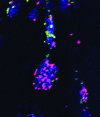Quorum sensing and biofilm formation in Streptococcal infections
- PMID: 14660736
- PMCID: PMC281653
- DOI: 10.1172/JCI20430
Quorum sensing and biofilm formation in Streptococcal infections
Abstract
Members of the bacterial genus Streptococcus are responsible for causing a wide variety of infections in humans. Many Streptococci use quorum-sensing systems to regulate several physiological properties, including the ability to incorporate foreign DNA, tolerate acid, form biofilms, and become virulent. These quorum-sensing systems are primarily made of small soluble signal peptides that are detected by neighboring cells via a histidine kinase/response regulator pair.
Figures



Similar articles
-
Quorum sensing in streptococcal biofilm formation.Trends Microbiol. 2005 Jan;13(1):3-6. doi: 10.1016/j.tim.2004.11.009. Trends Microbiol. 2005. PMID: 15639624 Review.
-
Inhibiting effects of Streptococcus salivarius on competence-stimulating peptide-dependent biofilm formation by Streptococcus mutans.Oral Microbiol Immunol. 2009 Apr;24(2):152-61. doi: 10.1111/j.1399-302X.2008.00489.x. Oral Microbiol Immunol. 2009. PMID: 19239643
-
Biofilm-specific surface properties and protein expression in oral Streptococcus sanguis.Arch Oral Biol. 2004 Apr;49(4):295-304. doi: 10.1016/j.archoralbio.2003.12.001. Arch Oral Biol. 2004. PMID: 15003548
-
Effects of quorum sensing on cell viability in Streptococcus mutans biofilm formation.Biochem Biophys Res Commun. 2009 Feb 20;379(4):933-8. doi: 10.1016/j.bbrc.2008.12.175. Epub 2009 Jan 10. Biochem Biophys Res Commun. 2009. PMID: 19138664
-
Can the ecology of the dental biofilm be beneficially altered?Adv Dent Res. 2009;21(1):69-73. doi: 10.1177/0895937409335641. Adv Dent Res. 2009. PMID: 19717412 Review. No abstract available.
Cited by
-
Antimicrobial and anti-Quorum Sensing activities of selected medicinal plants of Ethiopia: Implication for development of potent antimicrobial agents.BMC Microbiol. 2016 Jul 11;16(1):139. doi: 10.1186/s12866-016-0765-9. BMC Microbiol. 2016. PMID: 27400878 Free PMC article.
-
The BceABRS four-component system regulates the bacitracin-induced cell envelope stress response in Streptococcus mutans.Antimicrob Agents Chemother. 2010 Sep;54(9):3895-906. doi: 10.1128/AAC.01802-09. Epub 2010 Jul 6. Antimicrob Agents Chemother. 2010. PMID: 20606066 Free PMC article.
-
Pneumolysin promotes host cell necroptosis and bacterial competence during pneumococcal meningitis as shown by whole-animal dual RNA-seq.Cell Rep. 2022 Dec 20;41(12):111851. doi: 10.1016/j.celrep.2022.111851. Cell Rep. 2022. PMID: 36543127 Free PMC article.
-
Characteristics of biofilm formation by Streptococcus mutans in the presence of saliva.Infect Immun. 2008 Sep;76(9):4259-68. doi: 10.1128/IAI.00422-08. Epub 2008 Jul 14. Infect Immun. 2008. PMID: 18625741 Free PMC article.
-
Deep sequencing of the oral microbiome reveals signatures of periodontal disease.PLoS One. 2012;7(6):e37919. doi: 10.1371/journal.pone.0037919. Epub 2012 Jun 4. PLoS One. 2012. PMID: 22675498 Free PMC article.
References
-
- Carlsson J, Soderholm G, Almfeldt I. Prevalence of Streptococcus sanguis and Streptococcus mutans in the mouth of persons wearing full-dentures. Arch. Oral Biol. 1969; 14:243–249. - PubMed
-
- Burne RA. Oral streptococci . . . products of their environment. J. Dent. Res. 1998; 77:445–452. - PubMed
-
- Kleerebezem M, et al. Quorum sensing by peptide pheromones and two-component signal-transduction systems in Gram-positive bacteria. Mol. Microbiol. 1997; 24:895–904. - PubMed
Publication types
MeSH terms
Substances
LinkOut - more resources
Full Text Sources
Other Literature Sources
Medical

